| The Greek islands | Limnos HOME | Limnos Hotels | Limnos Beaches | Limnos Villages | Limnos Sights |
|
|
|
|
|
|
|
|
|
|
|
|
| The capital Myrina and other settlements on the island of Limnos |
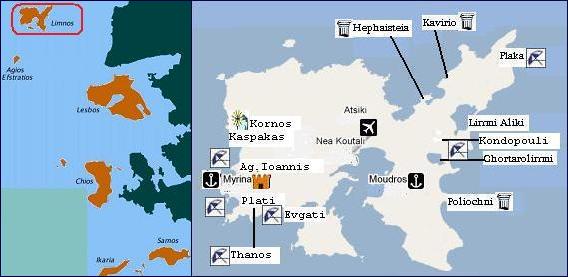
The capital and center of island life of the island is situated on the south west side of the island and is called Myrina / Mirina or Kastro. Myrina dates from the 12th / 13th century and is a town with a long history. It is named after the wife of the first king of the island, Thoantas. In 1276 the city was renamed Paliokastro, after that it was named Kastro untill 1955 and finally it was named Myrina again. It is a colourful town and one of the more popular places for tourists to choose an accommodation. Miryna is a traditional village with 5000 inhabitants. It is a working town more than a tourist town and it has interesting small backstreets full of small shops where you can buy the traditional products and the specialities of the island, like the goat cheese, almonds, figs, honey or the wine that is made on Limnos. The focal point of the small town is the medieval Kastro or castle that stands on a rock in between the two bays of the village. The Kastro of Myrina is build on the site of an ancient acropolis. It is one of the largest castles in the area. The Byzantine Emperor Andronikos I started the construction in 1186 AD and the Venetian that ruled the island in between 1207 and 1269 completed it. In 1269 the island of Limnos came into Byzantine hands again and the castle was made even stronger. Large parts of the walls and gates have been restored after much was damaged by the Russians when they besieged the castle in 1770. It is worth to make the climb to the castle and have a look around. Remarkable is that there are a lot of deer walking around free in the large walled premises of the castle. From the castle there are also amazing views. On a clear day you can see the holy mountain Athos (2033 m) on Chalkidiki peninsula. The northern bay of Myrina has a wide beach (Romeikos Yialos beach, with trees for shade) and the southern bay has a fishing harbour with colourful kaiks (wooden boats) and another sandy beach (Nea Maditos beach). Along the boulevard that leads along the beach you find traditional houses, but also some hotels, kafenions and tavernes. Myrina has an Archeological Museum (open 8.30 - 15.00) which is housed in the former residence of the Turkish governor. There are finds from several periods on display, from pre-historic, Archaïc and Hellenistic times (statues, pottery etc). |
| The tourist village of Moudros on the island of Limnos |
|
The village of Moudros also has some tourist facilities and accommodations. There are tavernes, bars, clubs, shops, banks, small shops and a post office in Moudros. Inside the village of Moudros itself are also two interestting churches. The largest one is the church of Annunciation which dominates the village and at the end of the market street you can find a church that dated from the Byzantine time. Close to Moudros are three beautiful sandy beaches in a row: Chavouli, Sagrida and Fanaraki. At the last beach you can also find a tavern and a beach bar. These beaches can be found south of Moudros and they are in a landscape with vulcanic rocks. The road leading to the beaches is unpaved and more suitable for a 4-wheel drive car. Near Moudros set high on a hill are the ruins of the Palaiokastro castle which was destroyed by the Venetians in 1656. This is the oldest castle of the island of Limnos. Following the coastline of Moudros in a northern direction along the bay you will pass a small islet (which is connected to Limnos) where a prehistoric settlement was discovered, much like Poliochni. This prehistoric settlement is known as Koukonisi. Excavations that started in 1992 have proved a Minoan presence on the islet (Minoërs were the original inhabitants of Crete and Santorini). Pottery with Minoan motifs have been found here proving that the island of Limnos traded with the Minoan island of Crete. Unfortunately the small islet is not open to the public. |
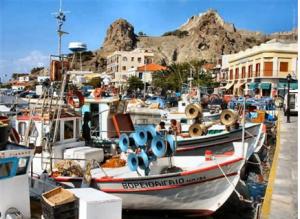 |
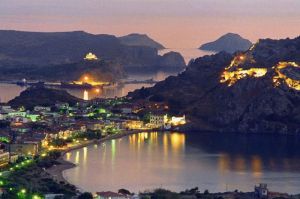 |
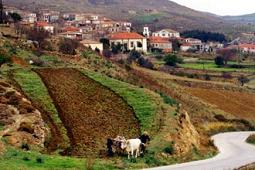 |
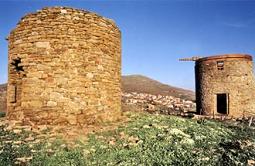 |
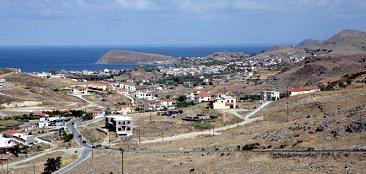 |
| Villages in the west of the island Limnos |
|
Kaspakas is the name of a village which is situated five to six kilometers north of the capital Myrina. It is situated at the foot of the mountain Agios Anastasios. Its name dates from Byzantine times. It is named after general Katalakos Kaspakas that came to the island in 883 AD to solve a dispute between the monks and the local inhabitants. The village is build in the hills as a protection against pirate raids. In the traditional village of Kaspakas you will find old mansions and many narrow paved streets. Kaspakas is a working village of about 800 people. Kornos, a village north of the capital Myrina, is build on the slopes of a hill called Skourta. It is set in an amphitheatrical way facing south in a green surrounding. The name Kornos derives from the "Krounos" (which means "tap" or "water tap") in the middle of the village which used to supply the village with water. Kornos was a prosperous and rich village, which is still reflected in the grandeur of some of the large old village houses. Some of the locals refer to it as "Little Paris". Besides the large village houses there are two rows of old windmills in the village of Kornos. Plati (or: Platy) is a small but picturesque village with white washed houses and red tiled roofs, set on the top of a green hill, a little south of the capital Myrina (2 kilometer). In the village there is a large white church with a bell tower. Down below in the green and fertile plain in front of Plati is one of the prettiest sandy beaches (700 meter long) of Limnos and there is a port with sailing boats and small yachts. This beach is an organized beach with amenities (water sport facilities) and it is one of the more busy beaches of the island. It comes with tavernes, bars, a supermarket and a couple of accommodations. The beach is is popular with both the tourists and the local people and since it is shallow it is also safe for children. Next to Plati is the village of Thanos which lies in a green area and is surrounded by low hills. Thanos is situated at 4 kilometer distance from the capital Myrina in the southwest of the island. In Thanos there is also a long sandy beach. The waters at the beach are cristal clear and it is surrounded by strangely shaped vulcanic rocks. The actual village of Thanos is situated a bit higher up the hill and overlooks the bay. Thanos is an old and pretty village with white houses with red roofs and with narrow streets. In the village you can find a couple of kafenions, a taverna and some shops. There are some simple accommodations on offer in the village of Thanos. |
| Villages in the east of the island of Limnos |
|
Kondopouli is a small village in the east of the island, near the two lakes of Limnos. Here is a large square with two churches. Plaka is a small village with white painted houses and a white church. The village lies entirely in the northeast of the island of Limnos. There is a small fishing port and you can find a path to the beach of Agios Stefanos here. |
© Hans Huisman, Varos Village Hotel, Archontiko Hotel, https://www.angelfire.com/super2/greece/ 2014
 The other main tourist destination and settlement of some substance of Limnos is the coastal village of Moudros, which is situated on the east side of the Bay of Moudros, not far from the airport (since so few planes fly to the island of Limnos you don't have to worry about noise!). Moudros is the capital of the Municipality of Moudros and it dates from the 14th century. The bay of Moudros is one of the largest natural harbours in the Aegean.
This was the place where the Greek navy moored during the war for independance against the Turks (1912), and during World War I the area was used as a base of the Allied Powers. Just outside outside Moudros the military cemetery for allied soldiers is a reminder for the battles that took place here.
The other main tourist destination and settlement of some substance of Limnos is the coastal village of Moudros, which is situated on the east side of the Bay of Moudros, not far from the airport (since so few planes fly to the island of Limnos you don't have to worry about noise!). Moudros is the capital of the Municipality of Moudros and it dates from the 14th century. The bay of Moudros is one of the largest natural harbours in the Aegean.
This was the place where the Greek navy moored during the war for independance against the Turks (1912), and during World War I the area was used as a base of the Allied Powers. Just outside outside Moudros the military cemetery for allied soldiers is a reminder for the battles that took place here.